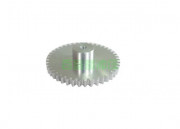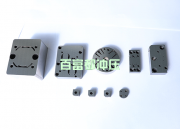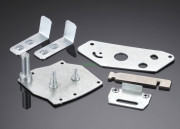First, we can see the information from the situation of the waste.
The scrap is essentially the inverse of the formed hole. That is, the same part in the opposite position. By carefully inspecting the scrap, you can infer whether the upper and lower die gaps are accurate. If the gap is too large, the scrap will exhibit rough, undulating fracture surfaces and a narrow bright band area. The larger the gap, the greater the angle the fracture surface makes with the bright band area. If the gap is too small, the scrap will exhibit a small angled fracture surface and a wide bright band area.
Excessive clearance creates holes with large curls and edge tearing, leaving the cut face slightly protruding with a thin edge. A gap that is too small results in a slight hemming of the tape and a large angular tear, resulting in the cut plane being more or less perpendicular to the surface of the material.
An ideal scrap should have a reasonable collapse angle and a uniform bright band. This keeps the punching force low and creates a clean round hole with very few burrs. From this point of view, increasing the die life by increasing the clearance is at the expense of finished hole quality.
Second, the choice of mold clearance
The clearance of the die is related to the type and thickness of the material being punched. Unreasonable clearance can cause the following problems:
(1) If the gap is too large, the burr of the punched workpiece is relatively large, and the quality of the punched product is poor. If the clearance is too small, although the quality of the punched product is good, the wear of the die is quite serious, which greatly reduces the service life of the die and easily causes the punch to break.
(2) If the gap is too large or too small, it is easy to cause adhesion on the punch material, which will cause the material to be tapered during punching. If the gap is too small, it is easy to form a vacuum between the bottom surface of the punch and the sheet, and the waste will bounce back.
(3) Reasonable clearance can prolong the life of the mold, the discharge effect is good, the burrs and flanging are reduced, the plate is kept clean, the hole diameter is consistent and the plate will not be scratched, the number of sharpening is reduced, the plate is kept straight, and the punching positioning is accurate.
3. How to improve the service life of the mold
For users, improving the service life of the mold can greatly reduce the stamping cost. The reasons that affect the service life of the mold are as follows:
1. The type and thickness of the material.
2. Whether to choose a reasonable die gap.
3. The internal structure of the mold.
4. Whether the material is well lubricated during stamping.
5. Whether the mold has undergone special surface treatment.
6. Such as titanium plating, titanium carbonitride.
7. The neutrality of the upper and lower turrets.
8. Adjust the rational use of gaskets.
9. Whether the oblique edge mold is used properly.
10. Whether the die base of the machine tool has been worn.
Fourth, the problems that should be paid attention to when punching special size holes
(1) Please use a special punch for punching in the range of φ0.8-φ1.6 with the minimum hole diameter.
(2) When punching a thick plate, use a die one size larger than the hole diameter. Note: At this time, if a normal size die is used, the punch thread will be damaged.
(3) For the cutting edge of the punch, the ratio of the minimum width to the length should generally not be less than 1:10.
(4) The relationship between the minimum size of the punch edge part and the plate thickness. It is recommended that the smaller size of the punch edge part be 2 times the thickness of the plate.
5. Sharpening of the mold
1. The importance of mold sharpening
Regular sharpening of the die is the guarantee of consistent punching quality. Regular sharpening of the mold can not only improve the service life of the mold but also improve the service life of the machine. It is necessary to master the correct sharpening timing.
2. The specific characteristics of the mold that needs to be sharpened
For die sharpening, there is no strict number of blows to determine if sharpening is required. mainly depends on
The sharpness of the cutting edge. It is mainly determined by the following three factors:
(1) Check the fillet of the cutting edge. If the fillet radius reaches R0.1 mm (the maximum R value must not exceed 0.25 mm), it needs to be sharpened.
(2) Check the punching quality, is there a large burr?
(3) Judge whether sharpening is required by the noise of machine stamping. If the noise is abnormal when the same pair of die is punched, it means that the punch is dull and needs to be sharpened.
Note: If the edge of the cutting edge becomes rounded or the rear of the cutting edge is rough, sharpening should also be considered.
3. The method of sharpening
There are many ways to sharpen the mold, which can be realized by a special sharpening machine or a surface grinder. The frequency of punch and die sharpening is generally 4:1. Please adjust the height of the die after sharpening.
(1) Harm of incorrect sharpening method: Incorrect sharpening will aggravate the rapid destruction of the die edge, resulting in a greatly reduced number of blows per sharpening.
(2) The benefits of the correct sharpening method: regularly sharpening the mold, the quality and precision of the punching can be kept stable. The cutting edge of the mold is damaged slowly and has a longer life.
4. Sharpening rules
The following factors should be considered when sharpening the mold:
(1) The fillet of the cutting edge depends on the sharpness of the cutting edge in the case of R0.1-0.25 mm.
(2) The surface of the grinding wheel should be cleaned.
(3) It is recommended to use a loose, coarse-grained, soft grinding wheel. Such as WA46KV
(4) The amount of grinding each time (the amount of knife cutting) should not exceed 0.013 mm. Excessive grinding will cause the surface of the mold to overheat, which is equivalent to annealing treatment, and the mold becomes soft, which greatly reduces the life of the mold.
(5) Sufficient coolant must be added during sharpening.
(6) When grinding, the punch and the lower die should be fixed smoothly, and a special fixture should be used.
(7) The sharpening amount of the mold is certain. If this value is reached, the punch will be scrapped. If you continue to use it, it is easy to cause damage to the mold and the machine, which is not worth the loss.
(8) After sharpening, the edge should be treated with whetstone to remove excessively sharp ridges.
(9) After sharpening, it should be cleaned, demagnetized and oiled.
Note: The amount of die sharpening mainly depends on the thickness of the punched sheet.
Six, the punch should pay attention before using
1. Storage
(1) Wipe the inside and outside of the upper die sleeve with a clean rag.
(2) Be careful not to scratch or dent the surface during storage.
(3) Oiled to prevent rust.
2. Preparation before use
(1) Thoroughly clean the upper die sleeve before use.
(2) Check the surface for scratches and dents. If so, remove with whetstone.
(3) Oiling inside and out.
3. Matters needing attention when installing the punch on the upper die sleeve
(1) Clean the punch and oil its shank.
(2) Insert the punch into the bottom of the upper die sleeve on the large-station die without using force. Nylon hammers cannot be used. During installation, the punch cannot be fixed by tightening the bolts on the upper die sleeve, and the bolts can only be tightened after the punch is positioned correctly. Zhengquan Technology WeChat content is really good, it is worth paying attention to!
4. Install the upper die combination into the turret
If you want to prolong the service life of the mold, the gap between the outer diameter of the upper die sleeve and the turret hole should be as small as possible. So please perform the following procedures carefully.
(1) Clean and oil the keyway and inner diameter of the turret hole.
(2) Adjust the keyway of the upper die guide sleeve to match the key of the turret hole.
(3) Insert the upper die sleeve straight into the tower hole, being careful not to have any inclination. The upper die guide should slide under its own weight into the turret hole.
(4) If the upper die sleeve is inclined to one side, use a soft material tool such as a nylon hammer to tap it gently and repeatedly until the upper die guide sleeve slides into the correct position by its own weight.
Note: Do not use force on the outer diameter of the upper die guide sleeve, but only on the top of the punch. Do not tap the top of the upper die sleeve, so as not to damage the turret hole and shorten the service life of individual stations.
Seven, mold maintenance
If the punch is caught by the material and cannot be taken out, please check the items listed below.
1. Re-sharpening of punch and lower die. A mold with a sharp edge can process a beautiful cut surface. If the edge is blunt, additional punching force is required, and the workpiece has a rough section, which produces great resistance, causing the punch to be bitten by the material.
2. The gap of the mold. If the gap of the die is not properly selected relative to the thickness of the plate, the punch needs a large demoulding force when it is separated from the material. If this is the reason the punch is bitten by the material, please replace the lower die with a reasonable clearance. Zhengquan Technology WeChat content is really good, worthy of attention!!
3. The state of the processed material. When the material is dirty or dirty, the dirt adheres to the die and the punch is caught by the material and cannot be processed.
4. Deformed materials. The warped material clamps the punch after the hole is punched, causing the punch to bite. For warped materials, please flatten them before processing.
5. Excessive use of springs. will fatigue the spring. Always pay attention to check the performance of the spring.
Eight, oiling
The amount of oil and the number of oil injections depend on the conditions of the material being processed. For cold-rolled steel plates, corrosion-resistant steel plates and other rust-free and non-scaling materials, oil should be injected into the mold. The oil injection points are the guide bush, the oil injection port, the contact surface between the cutter body and the guide bush, and the lower die. Use light motor oil.
For materials with rust and scale, the rust powder will be sucked between the punch and the guide sleeve during processing, resulting in dirt, so that the punch cannot slide freely in the guide sleeve. In this case, if oil is applied, it will make the rust easier Therefore, when flushing this material, on the contrary, wipe the oil clean, decompose it once a month, use gasoline (diesel) oil to remove the dirt on the punch and the lower die, and wipe it before reassembly. This ensures that the mold has good lubricating properties.
Nine, the problems and solutions that often occur during the use of the mold
Problem 1. The plate comes out of the clamping jaw
Reason: incomplete unloading of the mold
Solution:
1. Use a taper punch
2. Apply lubricating fluid on the plate
3. Adopt heavy duty mould
Problem 2, the mold is seriously worn
Reason: unreasonable die gap (small)
Solution: increase the mold gap
Reason: The upper and lower die bases are not aligned
Solution:
1. Work station adjustment, centering of upper and lower molds
2. Turret level adjustment
Reason: The worn mold guide components and the inserts of the turret were not replaced in time
Solution: replace
Reason: Punch overheating
Solution:
1. Add lubricating fluid to the sheet
2. Ensure lubrication between punch and lower die
3. Use multiple sets of molds of the same size in the same program
Reason: improper sharpening method, resulting in annealing of the mold, resulting in increased wear
Solution:
1. Use soft abrasive grinding wheel
2. Clean the grinding wheel frequently
3. Small amount of knife
4. Sufficient coolant
Reason: small step
Solution:
1. Increase the step distance
2. Adopt bridge nibbling
Problem 3. Punch material and punch sticking
Reason: unreasonable die gap (small)
Solution: increase the mold gap
Reason: Passivation of punch edge
Solution: sharpen in time
Reason: poor lubrication
Solution: Improve lubrication conditions
Problem 4. Scrap rebound
Reason: die problem
Solution:
1. Using bulletproof material to lower the mold
2. For small diameter holes, the clearance is reduced by 10%
3. When the diameter is greater than 50.00 mm, the gap is enlarged
4. Increase scratches on the edge side of the die
Reason: punch
Solution:
1. Increase the depth of the mold
2. Install the unloading polyurethane ejector bar
3. Adopt oblique cutting edge
Problem 5. Difficulty in unloading
Reason: unreasonable die gap (small)
Solution: increase the mold gap
Reason: punch wear
Solution: sharpen in time
Cause: Spring fatigue
Solution: replace the spring
Reason: Punch sticking
Solution: Remove the sticking
Question six, rush
Read More →






















